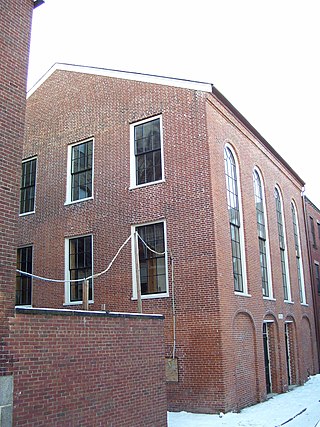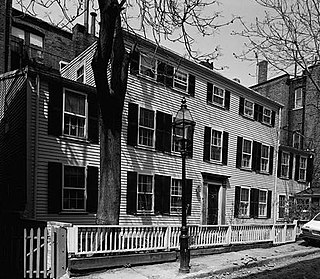
Shadwell is a census-designated place (CDP) in Albemarle County, Virginia. It is located by the Rivanna River near Charlottesville. The site today is marked by a Virginia Historical Marker to mark the birthplace of President Thomas Jefferson. It is listed on the National Register of Historic Places along with Clifton.

The Boston African American National Historic Site, in the heart of Boston, Massachusetts's Beacon Hill neighborhood, interprets 15 pre-Civil War structures relating to the history of Boston's 19th-century African-American community, connected by the Black Heritage Trail. These include the 1806 African Meeting House, the oldest standing black church in the United States.

The Germantown White House is a historic mansion in the Germantown section of Philadelphia, Pennsylvania. It is the oldest surviving presidential residence, having twice housed Founding Father George Washington during his presidency.

Philander Smith University is a private historically black college in Little Rock, Arkansas. It is affiliated with the United Methodist Church and is a founding member of the United Negro College Fund (UNCF). Philander Smith College is accredited by the Higher Learning Commission.

Holmes Run Acres is a community of 355 houses in Fairfax County, Virginia, in the Washington, D.C. suburbs. Nearly all of the neighborhood is within the Holmes Run Acres Historic District, listed on the National Register of Historic Places.

Stagville Plantation is located in Durham County, North Carolina. With buildings constructed from the late 18th century to the mid-19th century, Stagville was part of one of the largest plantation complexes in the American South. The entire complex was owned by the Bennehan, Mantack and Cameron families; it comprised roughly 30,000 acres (120 km2) and was home to almost 900 enslaved African Americans in 1860.

Woodlawn is a historic house located in Fairfax County, Virginia. Originally a part of Mount Vernon, George Washington's historic plantation estate, it was subdivided in the 19th century by abolitionists to demonstrate the viability of a free labor system. The address is now 9000 Richmond Highway, Alexandria, Virginia, but due to expansion of Fort Belvoir and reconstruction of historic Route 1, access is via Woodlawn Road slightly south of Jeff Todd Way/State Route 235. The house is a designated National Historic Landmark, primarily for its association with the Washington family, but also for the role it played in the historic preservation movement. It is now a museum property owned and managed by the National Trust for Historic Preservation.

The George W. Smith House is a home in the Chicago suburb of Oak Park, Illinois, United States designed by American architect Frank Lloyd Wright in 1895. It was constructed in 1898 and occupied by a Marshall Field & Company salesman. The design elements were employed a decade later when Wright designed the Unity Temple in Oak Park. The house is listed as a contributing property to the Ridgeland-Oak Park Historic District which joined the National Register of Historic Places in December 1983.

The President's House, also known as the John Maclean House, or simply the Maclean House, in Princeton, Mercer County, New Jersey, United States, was built to serve as the home of the President of the College of New Jersey, which later became Princeton University. It was completed in 1756, the same year as Nassau Hall. United States Founding Father John Witherspoon lived here from 1768 through 1779, during which time he served as a delegate to the Continental Congress and signed the Declaration of Independence. George Washington occupied Maclean House in January 1777, during the Battle of Princeton and in 1783 while Congress met in Nassau Hall.

The William C. Nell House, now a private residence, was a boarding home located in 3 Smith Court in the Beacon Hill neighbourhood of Boston, Massachusetts, opposite the former African Meeting House, now the Museum of African American History.

Glenview Mansion is a historic home and surrounding property located at Rockville, Montgomery County, Maryland. The house is a 1926 Neo-Classical Revival style house on 65 acres (260,000 m2) of landscaped ground. The five-part mansion incorporates the remnants of the 1838 house called "Glenview." Since 1957, the house and grounds have been owned by the City of Rockville, and are used for various civic, cultural and social events, and is known as Rockville Civic Center Park. The house also includes the Glenview Mansion Art Gallery.

The Melvyn Maxwell Smith and Sara Stein Smith House, also known as MyHaven, is a Frank Lloyd Wright designed Usonian home that was constructed in Bloomfield Hills, Michigan in 1949 and 1950. The owners were two public school teachers living on a tight budget. The 1957 landscape design is by Thomas Dolliver Church. The home is now on the National Register of Historic Places.

The Murphy House is a historic Greek Revival style house in Montgomery, Alabama. The two-story masonry building was built for John H. Murphy, a Virginia cotton and slavery merchant who owned a large warehouse at 122 Commerce Street, Montgomery, where slave traders in the 1850s confined slaves until they could be sold at auctions. The house was added to the National Register of Historic Places on March 24, 1972.

The Francis Land House, or Rose Hall, is a historic brick house in located within the Rose Hall District near Princess Anne Plaza in Virginia Beach, Virginia. It was the plantation home of the prominent Land family, a founding family of Princess Anne County, Virginia.

Gregg-Wallace Farm Tenant House is a historic home located near Mars Bluff, Florence County, South Carolina. It was built about 1890, and is representative of a typical Mars Bluff vernacular tenant house for African Americans. Tenant houses often evolved from one-room slave houses, first by the addition of a shed room at the rear and a front porch, then by the addition of a second room.

Slave Houses, Gregg Plantation is a set of two historic log slave cabins located on the campus of Francis Marion University at Mars Bluff, Florence County, South Carolina. There were originally 8 cabins, but only these two remnants survive. They were built before 1831, and occupied until the early 1950s.

The Boxwood Plantation Slave Quarter is a historic building near Trinity, in Lawrence County, Alabama. The plantation was founded in late 1810s by Samuel Elliot, an Ulsterman who had originally settled in Middle Tennessee. Elliott and his son, Samuel Jr., built Boxwood into one of the largest plantations in the county, with $36,000 in real property and 92 slaves by 1860. Both the main plantation house and the slave quarters were built in the mid-1850s. Although the main house was demolished in the 1950s to make way for the widening of Highway 20, the slave quarter was remodeled and continued to serve as a house. The surrounding area continued to operate as a farm until 2010, when the land was purchased to construct an industrial park. The quarter is being preserved, and the later alterations have been removed, revealing the building's original form.

The Windsor House is a historic former hotel building at 54 Main Street in Windsor, Vermont. Built in 1836, it was for many years a mainstay of the village's travel industry, whose famous guests include Theodore Roosevelt. Now converted to other commercial purposes, the building was listed on the National Register of Historic Places in 1971.

The J. Harper Smith Mansion is a historic Late Victorian house built in 1880 by James Harper Smith and located at 228 Altamont Place in the borough of Somerville in Somerset County, New Jersey, in the United States. The architect Horace Trumbauer designed the library addition in 1898. The privately owned residence was added to the National Register of Historic Places on December 31, 1998, for its significance in architecture from 1880 to 1911.

James Lindsay Smith was an American slave narrative author, minister, and shoemaker. His memoir Autobiography of James L. Smith (1881) was one of only six slave narratives published in Connecticut.






















